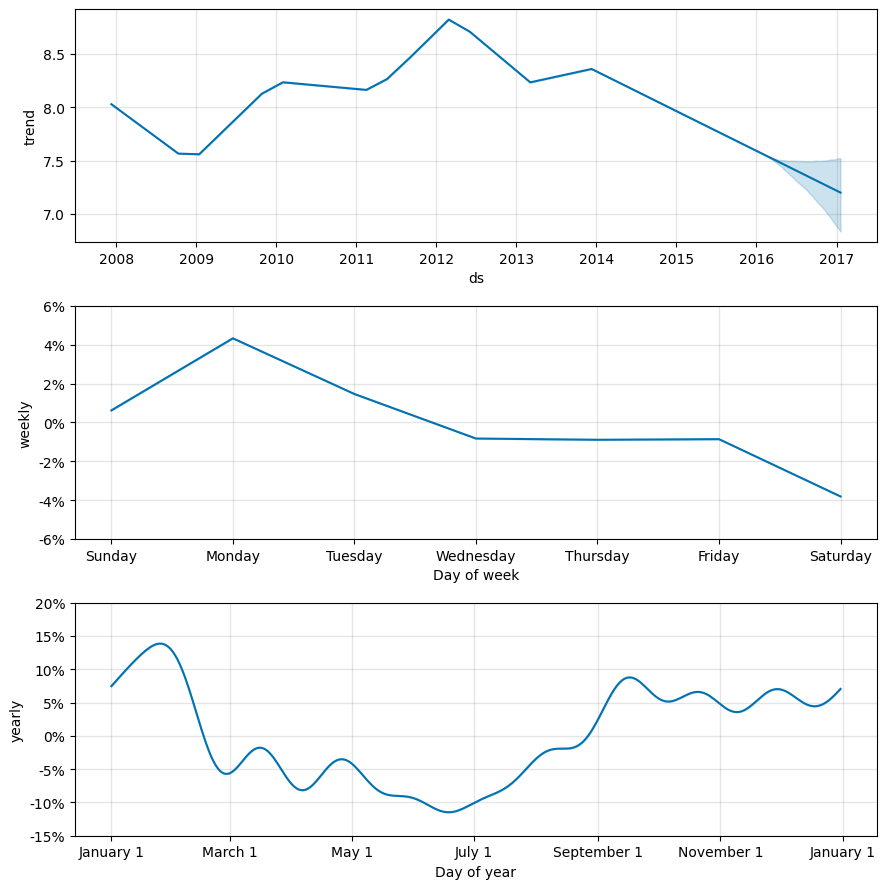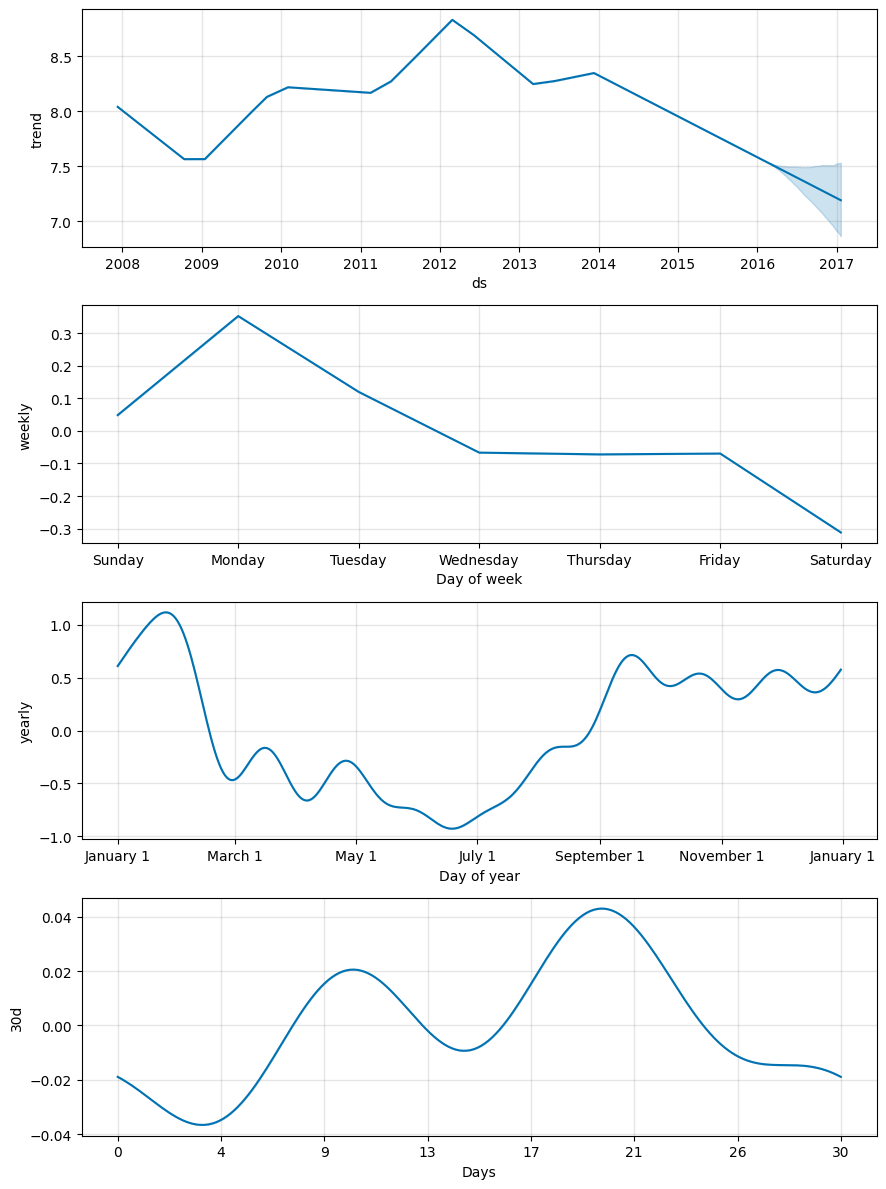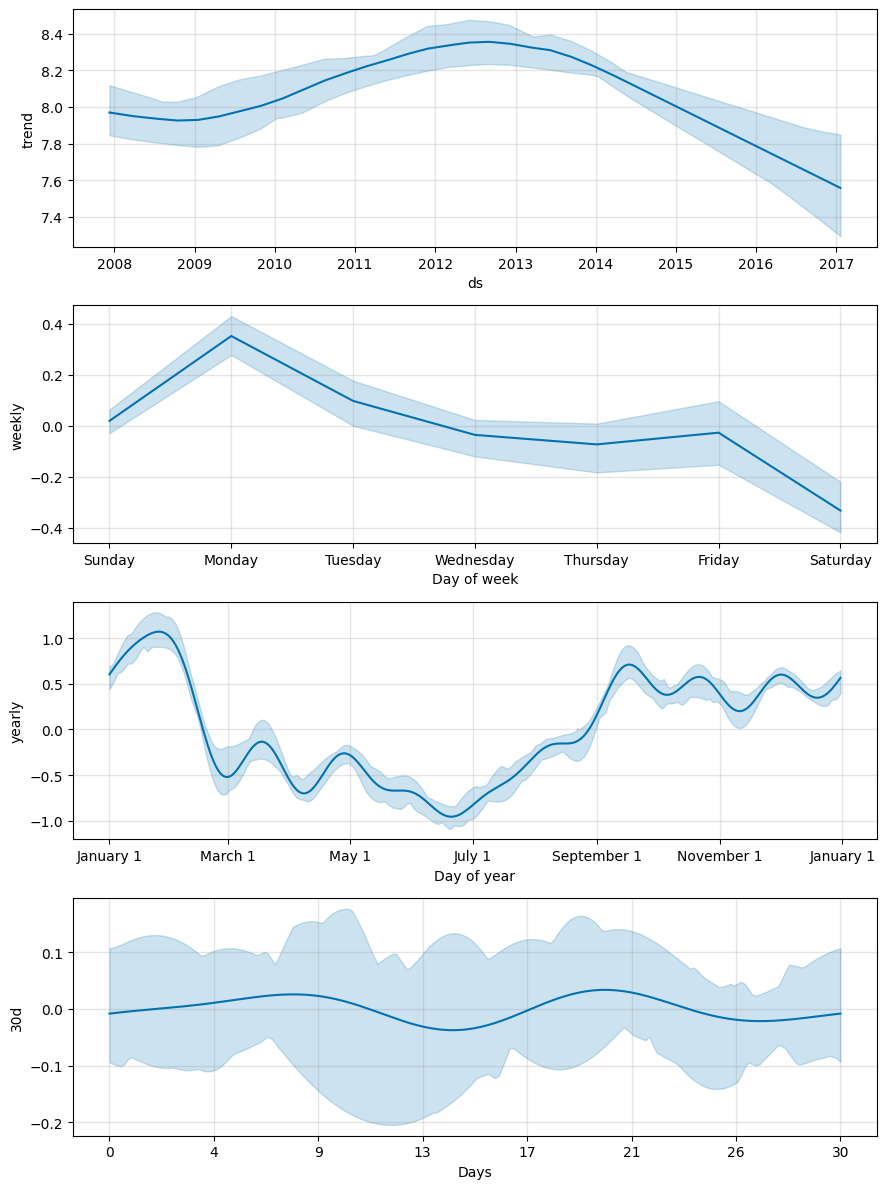Prophet Quick Start
数据格式
Prophet 的输入必须包含两列的数据框:ds 和 y 。
- ds 列必须包含日期(YYYY-MM-DD)或者是具体的时间点(YYYY-MM-DD HH:MM:SS)。
- y 列必须是数值变量,表示我们希望去预测的量。
example_wp_log_peyton_manning.csv下载地址:
import pandas as pd
from prophet import Prophet
# 读入数据集
df = pd.read_csv('data/example_wp_log_peyton_manning.csv')
print(df.tail(5))
"""
ds y
2900 2016-01-16 7.817223
2901 2016-01-17 9.273878
2902 2016-01-18 10.333775
2903 2016-01-19 9.125871
2904 2016-01-20 8.891374
"""
建模流程
通过使用辅助的方法 Prophet.make_future_dataframe 来将未来的日期扩展指定的天数,得到一个合规的数据框。
m = Prophet()
m.fit(df)
# 构建待预测日期数据框,periods = 365 代表除历史数据的日期外再往后推 365 天
horizon = 365
future = m.make_future_dataframe(periods=horizon)
future.tail(5)
"""
ds
3265 2017-01-15
3266 2017-01-16
3267 2017-01-17
3268 2017-01-18
3269 2017-01-19
"""
# 预测
forecast = m.predict(future)
# 通过 Prophet.plot 方法传入预测得到的数据框,可以对预测的效果进行绘图。
fig1 = m.plot(forecast)
# 使用 Prophet.plot_components 方法。默认情况下,将展示趋势、时间序列的年度季节性和周季节性。如果之前包含了节假日,也会展示出来。
fig2 = m.plot_components(forecast)

如果想查看预测的成分分析,可以使用 Prophet.plot_components 方法。默认情况下,将展示趋势、时间序列的年度季节性和周季节性。如果之前包含了节假日,也会展示出来。

Prophet详解
在上一篇文章【Prophet代码实战(一)趋势项调节】介绍了Prophet算法的趋势项。接下来我们开始介绍Prophet算法的季节项
季节性
Prophet的内置季节性
-
yearly_seasonality,是否需要拟合数据中的yearly季节性,以及yearly季节性的傅里叶级数项数。当训练集中有超过1年的数据时,默认为10,
一般来说拟合yearly的季节性建议至少有一年的数据。 -
yearly_seasonality越大,拟合的季节性曲线波动幅度越大
-
yearly_seasonality=0或者为False时,表示不拟合yearly季节性。
-
类似还有weekly_seasonaliyt和daily_seasonality。
# 调整yearly_seasonality
m = Prophet(yearly_seasonality=20)
m.fit(df)
horizon = 365
future = m.make_future_dataframe(periods=horizon)
forecast = m.predict(future)
fig = m.plot_components(forecast)

关闭yearly_seasonality
m = Prophet(yearly_seasonality=0)
m.fit(df)
horizon = 365
future = m.make_future_dataframe(periods=horizon)
forecast = m.predict(future)
fig = m.plot_components(forecast)
超参数seasonality_prior_scale
- 小数,季节性曲线的系数先验概率,默认值为10
- 理论上,seasonality_prior_scale越大,季节性曲线波动越大,越容易过拟合
# 调整seasonality_prior_scale = 10
m = Prophet(seasonality_prior_scale = 10)
m.fit(df)
horizon = 365
future = m.make_future_dataframe(periods=horizon)
forecast = m.predict(future)
fig = m.plot_components(forecast)

季节性的加法模式和乘法模式
超参数seasonality_mode
- “additive”:默认值,表示季节性对观测值是加法的作用,即y = trend + seasonality
- “multiplicative”:表示季节性对观测值是乘法作用,即y = trend * seasonality
- 一般business相关的时间序列只要选取"multiplicative"
- multiplicative和additive可以通过对数操作相互转化。即 y = trend * seasonality
可以表示为log(y) = log(trend) + log(seasonality)
# 调整seasonality_mode
m = Prophet(seasonality_mode="multiplicative")
m.fit(df)
horizon = 365
future = m.make_future_dataframe(periods=horizon)
forecast = m.predict(future)
fig = m.plot_components(forecast)

自定义季节性
通过函数add_seasonality()增加新的季节性,参数有:
- name:名称
- period:周期长度
- fourier_order:傅里叶级数项数
- prior_scale:傅里叶系数先验概率
# 通过函数add_seasonality()增加新的季节性
m = Prophet()
m.add_seasonality(name='30d',period=30,fourier_order=3,prior_scale=0.1)
m.fit(df)
horizon = 365
future = m.make_future_dataframe(periods=horizon)
forecast = m.predict(future)
fig = m.plot_components(forecast)

季节性的置信区间
超参数mcmc_samples,计算置信区间时的蒙特卡洛样本数量
- 默认情况下,Prophet只会返回趋势的置信区间,为了得到季节性的置信区间,我们需要做完全的贝叶斯抽样,采用是通过蒙特卡洛方法完成的。
- mcmc_samples越大,样本越具有代表性,置信区间越准,运算时间也会越久
# 通过mcmc_samples参数返回季节性趋势
m = Prophet(mcmc_samples=30)
m.add_seasonality(name='30d',period=30,fourier_order=3,prior_scale=0.1)
m.fit(df)
horizon = 365
future = m.make_future_dataframe(periods=horizon)
forecast = m.predict(future)
fig = m.plot_components(forecast)

























 1051
1051











 被折叠的 条评论
为什么被折叠?
被折叠的 条评论
为什么被折叠?










